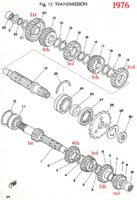Stoop22kid
XS650 Addict
Can someone please post a picture of what neutral looks like when the cases are split? My pictures got deleted and I can't find neutral for the life of me. I just need to know how to find neutral with the cases split and the transmission in the top case.
Please and thank you so much
Justin
Please and thank you so much
Justin











 I have no idea if the stator you have is correctly marked for your engine which is why you should always use your pistons to check TDC Then check /mark your stator.
I have no idea if the stator you have is correctly marked for your engine which is why you should always use your pistons to check TDC Then check /mark your stator.